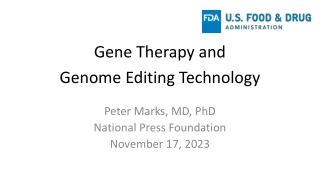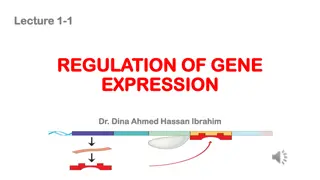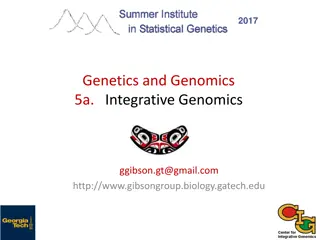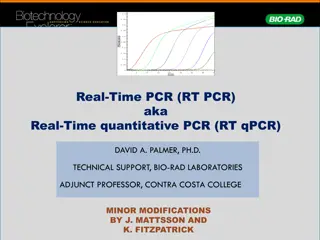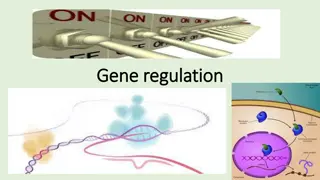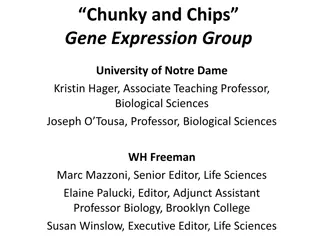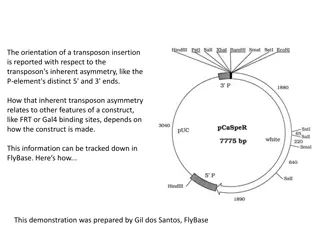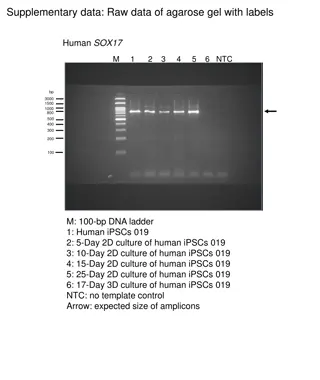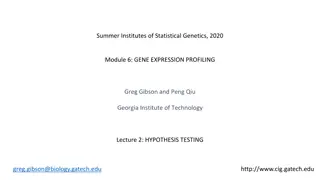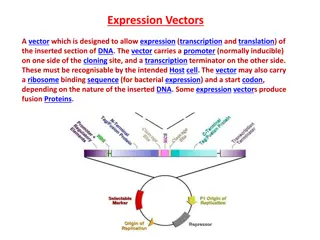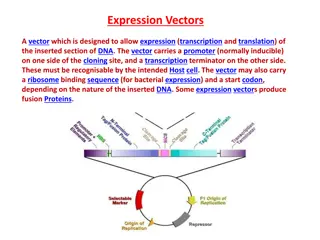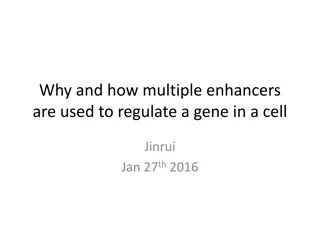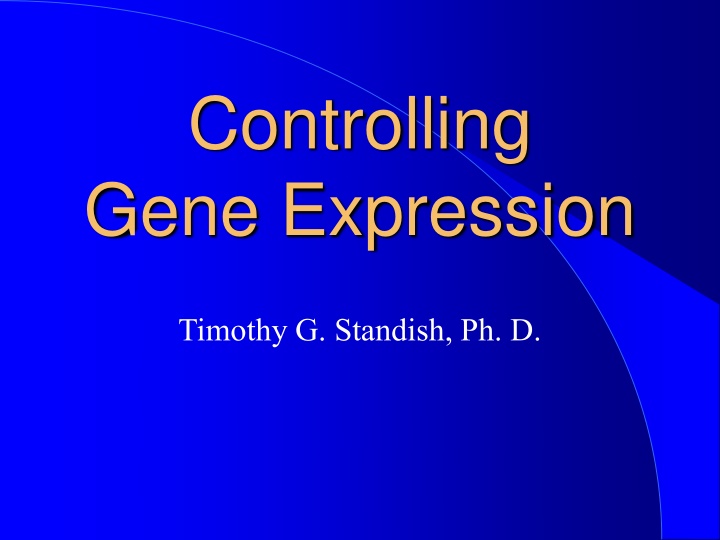
Gene Expression Control Mechanisms
Explore the intricate mechanisms of gene expression control, including constitutive and inducible genes, operons in prokaryotes, and the Lac operon system in E. coli. Learn how genes are regulated to ensure proper function and efficiency within cells.
Download Presentation

Please find below an Image/Link to download the presentation.
The content on the website is provided AS IS for your information and personal use only. It may not be sold, licensed, or shared on other websites without obtaining consent from the author. If you encounter any issues during the download, it is possible that the publisher has removed the file from their server.
You are allowed to download the files provided on this website for personal or commercial use, subject to the condition that they are used lawfully. All files are the property of their respective owners.
The content on the website is provided AS IS for your information and personal use only. It may not be sold, licensed, or shared on other websites without obtaining consent from the author.
E N D
Presentation Transcript
Controlling Gene Expression Timothy G. Standish, Ph. D.
All Genes Cant be Expressed At The Same Time Some genes are needed for the function of all cells all the time. These genes are called constitutive genes and are expressed by all cells. Other genes are only needed by certain cells or at specific times. The expression of these inducible genes is tightly controlled in most cells. For example, beta cells in the pancreas make the protein insulin by expressing the insulin gene. If neurons expressed insulin, problems would result.
Operons Are Groups Of Genes Expressed By Prokaryotes The genes grouped in an operon are all needed to complete a given task Each operon is controlled by a single control sequence in the DNA Because the genes are grouped together, they can be transcribed together then translated together
The Lac Operon Genes in the lac operon allow E. coli bacteria to metabolize lactose Lactose is a sugar that E. coli is unlikely to encounter, so it would be wasteful to produce the proteins needed to metabolize it unless necessary Metabolizing lactose for energy only makes sense when two criteria are met: Other more readily metabolized sugar (glucose) is unavailable Lactose is available
The Lac Operon - Parts The lac operon is made up of a control region and four genes The four genes are: LacZ - -galactosidase -An enzyme that hydrolizes the bond between galactose and glucose LacY - Codes for a permease that lets lactose across the cell membrane LacA - Transacetylase -An enzyme whose function in lactose metabolism is uncertain Repressor -A protien that works with the control region to control expression of the operon
The Lac Operon - Control The control region is made up of two parts: Promoter These are specific DNA sequences to which RNA Polymerase binds so that transcription can occur The lac operon promoter also has a binding site for another protein called CAP Operator The binding site of the repressor protein The operator is located down stream (in the 3 direction) from the promoter so that if repressor is bound RNA Polymerase can t transcribe
The Lac Operon: When Glucose Is Present But Not Lactose Come on, let me through Hey man, I m constitutive BindingRNA CAP Operator LacZ LacY LacA Repressor Promoter Pol. Repressor Repressor mRNA No way Jose! Repressor CAP
The Lac Operon: When Glucose And Lactose Are Present Great, I can transcribe! Hey man, I m constitutive RNA RNA Pol. CAP Operator X LacZ LacY LacA Repressor Promoter Pol. Binding Repressor mRNA Repressor This lactose has bent me out of shape CAP Repressor Repressor Some transcription occurs, but at a slow rate
The Lac Operon: When Lactose Is Present But Not Glucose Bind to me Polymerase Hey man, I m constitutive Yipee ! RNA RNA Pol. CAP Operator X LacZ LacY LacA Repressor Promoter Pol. Binding CAP cAMP Repressor mRNA Repressor CAP cAMP Repressor This lactose has bent me out of shape CAP Repressor cAMP
The Lac Operon: When Neither Lactose Nor Glucose Is Present Alright, I m off to the races . . . Bind to me Polymerase Hey man, I m constitutive Come on, let me through! RNA CAP Operator LacZ LacY LacA Repressor Promoter Pol. Binding CAP cAMP Repressor STOP Right there Polymerase Repressor mRNA CAP cAMP CAP Repressor cAMP
The Trp Operon Genes in the trp operon allow E. coli bacteria to make the amino acid tryptophan Enzymes encoded by genes in the trp operon are all involved in the biochemical pathway that converts the precursor chorismate to tryptophan. The trp operon is controlled in two ways: Using a repressor that works in exactly the opposite way from the lac operon repressor Using a special attenuator sequence
The Tryptophan Biochemical Pathway Glutamate + Pyruvate COO- 5-Phosphoribosyl- -Pyrophosphate NH2 Anthranilate synthetase -OOC Glutamine PPi COO- CH2 HN COO- O C O CH2 -2O3P O H Anthranilate synthetase (trpE and D) N-(5 - Phosphoribosyl) -anthranilate H H Chorismate Antrhanilate H H HO H N-(5 -Phosphoribosyl)-anthranilate isomerase Indole-3 -glycerol phosphate synthetase (trpC) OH OH OH OH OH OH CO2+H2O -OOC OH C C C -2O3PO CH2 C C C -2O3PO CH2 N-(5 -Phosphoribosyl)- Anthranilate isomerase Indole- 3 -glycerol phosphate synthetase H H Enol-1-o- Carboxyphenylamino -1-deoxyribulose phosphate H C H H C H N H N H Glyceraldehyde- 3-phosphate Tryptophan synthetase (trpB and A) Indole-3-glycerol phosphate H -OOC C CH2 H2O Serine NH3+ Tryptophan synthetase N H N H Indole Tryptophan
The Trp Operon: When Tryptophan Is Present Hey man, I m constitutive Foiled Again! RNA Operator Lead. Aten. trpE trpD trpC trpB trpA Repressor Promo. Pol. Repressor Trp Repressor mRNA STOP Right there Polymerase Trp Repressor
Attenuation The trp operon is controlled both by a repressor and attenuation Attenuation is a mechanism that works only because of the way transcription and translation are coupled in prokaryotes Therefore, to understand attenuation, it is first necessary to understand transcription and translation in prokaryotes
Transcription And Translation In Prokaryotes 5 3 3 5 RNA Pol. Ribosome mRNA Ribosome 5
The Trp Leader and Attenuator Met-Lys-Ala-Ile-Phe-Val- AAGUUCACGUAAAAAGGGUAUCGACA-AUG-AAA-GCA-AUU-UUC-GUA- Leu-Lys-Gly-Trp-Trp-Arg-Thr-Ser-STOP CUG-AAA-GGU-UGG-UGG-CGC-ACU-UCC-UGA-AACGGGCAGUGUAUU 1 2 CACCAUGCGUAAAGCAAUCAGAUACCCAGCCCGCCUAAUGAGCGGGCUUUU 3 4 Met-Gln-Thr-Gln-Lys-Pro UUUU-GAACAAAAUUAGAGAAUAACA-AUG-CAA-ACA-CAA-AAA-CCG trpE . . . Terminator
The mRNA Sequence Can Fold In Two Ways 1 2 1 2 3 3 4 4 Terminator haripin
The Attenuator When Starved For Tryptophan 5 3 3 5 Help, I need Tryptophan RNA Pol. 2 Ribosome 3 4 1
The Attenuator When Tryptophan Is Present 5 3 Ribosome 3 5 RNA Pol. Pol. RNA 2 3 4 1
Control Of Expression In Eukaryotes Some of the general methods used to control expression in prokaryotes are used in eukaryotes, but nothing resembling operons is known Eukaryotic genes are controlled individually and each gene has specific control sequences preceding the transcription start site In addition to controling transcription, there are additional ways in which expression can be controlled in eukaryotes
Eukaryotes Have Large Complex Geneomes The human genome is about 3 x 109 base pairs or 1 m of DNA Because humans are diploid, each nucleus contains 6 3 x 109base pairs or 2 m of DNA That is a lot to pack into a little nucleus!
Eukaryotic DNA Must be Packaged Eukaryotic DNA exhibits many levels of packaging The fundamental unit is the nucleosome, DNA wound around histone proteins Nucleosomes arrange themselves together to form higher and higher levels of packaging.
Highly Packaged DNA Cannot be Expressed The most highly packaged form of DNA is heterochromatin Heterochromatin cannot be transcribed, therefore expression of genes is prevented Chromosome puffs on some insect chomosomes illustrate where active gene expression is going on
Only a Subset of Genes is Expressed at any Given Time It takes lots of energy to express genes Thus it would be wasteful to express all genes all the time By differential expression of genes, cells can respond to changes in the environment Differential expression, allows cells to specialize in multicelled organisms. Differential expression also allows organisms to develop over time.
Control of Gene Expression Cytoplasm Packaging Degradation DNA Transcription Transportation RNA Modification RNA Processing Degradation etc. mRNA G G G AAAAAA AAAAAA AAAAAA Export Translation Nucleus
Logical Expression Control Points DNA packaging Transcription RNA processing mRNA Export mRNA masking/unmasking and/or modification mRNA degradation Translation Protein modification Protein transport Protein degradation Increasing cost The logical place to control expression is before the gene is transcribed
A Simple Eukaryotic Gene Transcription Start Site 3 Untranslated Region 5 Untranslated Region Introns 5 3 Exon 1 Int. 1 Int. 2 Exon 2 Exon 3 Promoter/ Control Region Terminator Sequence Exons RNA Transcript
Enhancers DNA Many bases 5 3 Enhancer Promoter Transcribed Region 3 5 TF TF 3 5 RNA Pol. RNA Pol. TF TF 5 RNA
Eukaryotic mRNA 5 Untranslated Region 3 Untranslated Region 5 3 G AAAAA Exon 1 Exon 2 Exon 3 Protein Coding Region 5 Cap 3 Poly A Tail RNA processing achieves three things: Removal of introns Addition of a 5 cap Addition of a 3 tail This signals the mRNA is ready to move out of the nucleus and may control its life span in the cytoplasm

